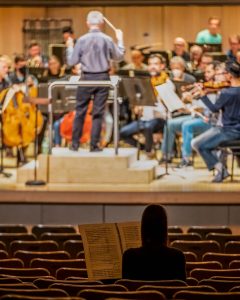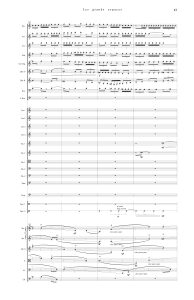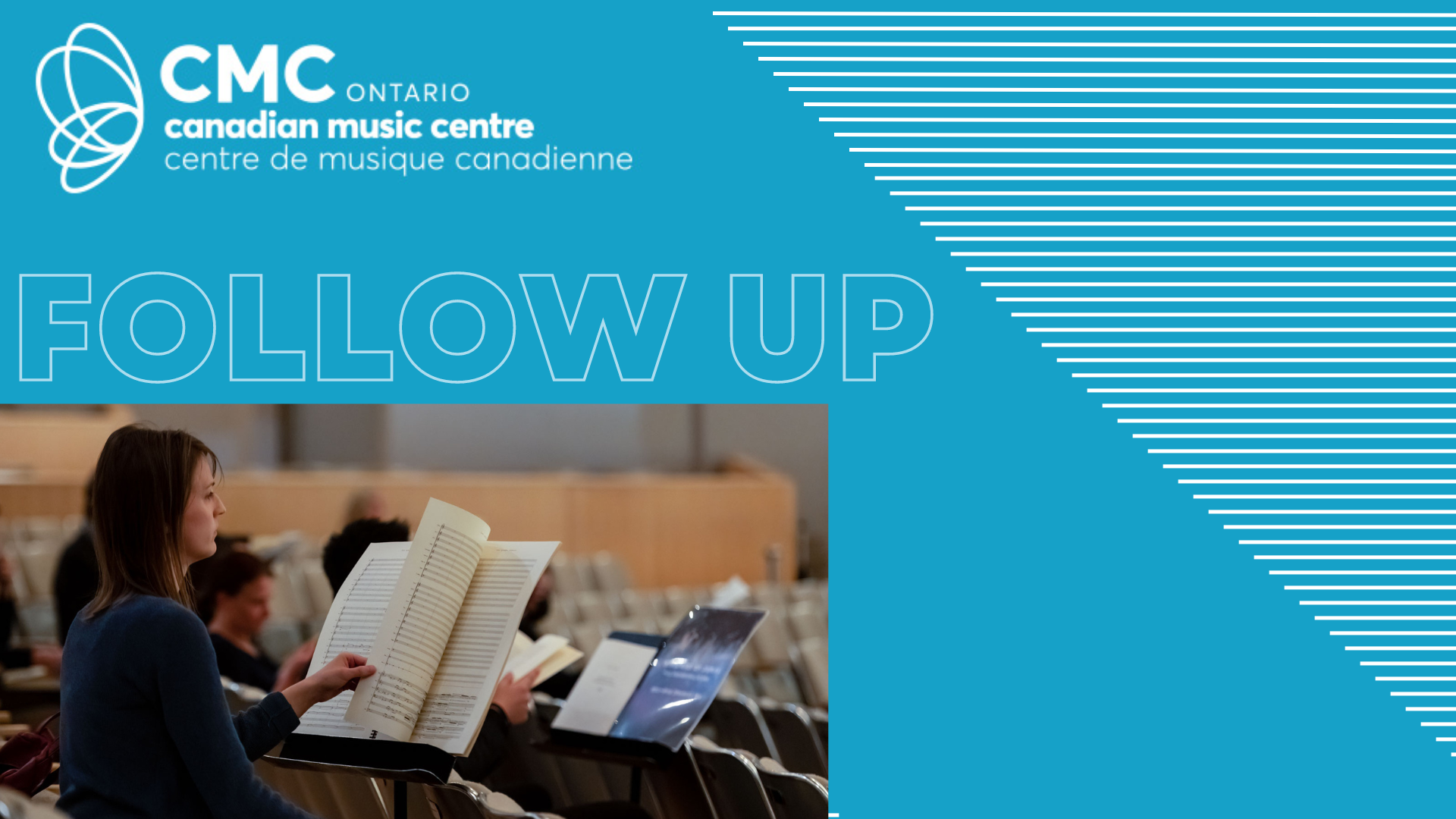CMC Ontario Regional Director Joseph Glaser sat down with Véronique Noël, a participant in the latest edition of the Toronto Symphony Orchestra’s Explore the Score program to discuss her participation in the reading session.
Since 2012, the TSO has given some of Canada’s top emerging composers an opportunity to hear their works rehearsed in a live professional orchestral setting. Presented in collaboration with the Canadian Music Centre (CMC), Explore the Score is part of an ongoing commitment to support the development of emerging Canadian composers and the creation of new orchestral works, and to offer the public a front-row seat in witnessing artistic creation first-hand. The program provides some of Canada’s promising composers an opportunity to hear their work performed in a professional orchestral setting and receive mentorship from artistic and administrative staff. The 2022 edition involved advising sessions from the TSO’s orchestral librarian Christopher Reiche-Boucher, RBC affiliate composer Alison Yun-Fei Jiang, TSO’s composer advisor Gary Kulesha, TSO’s music director Gustavo Gimeno, and guest composer Magnus Lindberg.
On October 22nd, the Toronto Symphony Orchestra read Véronique’s work Les grands espaces alongside works by Coreen Morsink, David Occhipinti, and Patrick Wu conducted by Gary Kulesha.
Joseph Glaser: Tell me a little bit about your background, how did you get into music?
Véronique Noël: I started playing the piano when I was four. When I was about ten or eleven, I wanted to try playing the glockenspiel that I had at my primary school. My parents, thankfully, were willing to get one so I could start private lessons on the instrument. This was the first experience that I had that made me realize that I could learn any instrument I wanted to. From that moment on I got increasingly interested in all sorts of instruments. When I was about 13, I saw a violinist play on TV and I was very impressed by it. It shocked me because the performance was impressive, the sound was beautiful and even the instrument looked beautiful. From that moment on I wanted to have a violin so badly, and convinced my parents to get me lessons. In this way I became a jack-of-all-trades, wanting to try and jam on any instrument that interested me. Although I was studying classical piano the entire time with a concert pianist curriculum, I knew that that path wasn’t for me. I always felt uncomfortable on stage which led me to question even going into music long term. Then I got access to Finale notation software and started directly composing for orchestra and that clicked for me. I thought “wow, this is what I really like doing, and this is the path I want to pursue”. I was even pretty decent at it, so I thought it might be a viable career path for me in music. That was the moment I fell in love with composition and here I am. I love the fact that I can be behind the scenes with it, a place I feel much more comfortable in than on stage. Now I’ve just finished a Master’s degree in composition at the Conservatoire de Musique de Montréal and am working to get my music out there.
JG: This piece [Les grands espaces] has now been read by a couple of different orchestras, what was the difference you found in working with the different orchestras?

VN: What I enjoyed the most with the TSO program was the meeting we had after the reading. What I find hard about working with musicians is that we never get real comments from them. Often, they’re too shy or too polite to tell us what they really think about the music. I don’t think there’s anything better than a good complaint from a musician or a conductor to really learn the lessons needed to become a better composer. I found that at the meeting with the TSO musicians and staff everyone was very kind but honest in their feedback. The meeting with [TSO Librarian] Christopher [Reiche-Boucher] was also really helpful before the reading. Through my studies we never really touched on the details of how to make a score presentable to an orchestra. That information is really useful to a composer.
The main difference I found between the reading with the TSO and the other one I participated in with the Orchestre Symphonique de Montréal is how they approached those two elements. I did, however find that by and large the feedback I received from both readings was pretty similar which just reinforces that the standard being taught is correct.
JG: Can you tell me a bit about the piece? How did you set out to achieve a feeling of space in the work as suggested by the title?
VN: The work, Les grands espaces, expresses the beauty, freedom of wide-open spaces and the loneliness we experience when one is surrounded by uninhabited landscapes. The work, quite literally represents the curves of mountains with ascending and descending lines for the instruments of the orchestra. I enjoy composing by translating images into technical parameters in the music like this. Given that, when writing I tend to compose fairly instinctively, not starting with a detailed pre-compositional plan but rather composing with real time emotion. Then over the weeks of the writing process, I then listen back to work internally and then organize it in a thoughtful way. Through this whole process, it’s a little difficult to pinpoint exactly what I was after with the idea of Les grands espaces but I think over all I was interested in representing the idea of freedom after finishing my studies at the Conservatoire. While writing the work I was looking forward to being able to compose without any imposed constraints from the curriculum. That desire to leave those concerns coupled with my enjoyment of the outdoors in solitude came together to inspire this piece.
JG: Describe the reading session from your perspective. 
VN: I was very happy with it! I was anticipating some difficulties with the reading given that we only had 30 minutes each to work with the musicians and the middle section of my piece has some fairly difficult rhythmic writing for the wind instruments. Even so, I was very impressed with the performance. I had changed a few things in the score after the reading with the OSM and I was very happy to hear those changes and to confirm that the changes improved the piece! The musicians really are so impressive it was a great experience.
JG: Do you have any takeaways from the experience? Now that you’ve heard the work (a second time), what are some things you would approach differently for the next piece you write for orchestra?
VN: The main lesson I learned is that the piece is maybe a bit too complicated for the context. The rhythms are too intense too often. There was also no place for the violins to turn the page. While at the reading, I was thinking of the work of my teacher, [CMC Associate Composer] Denis Gougeon’s Cello Concerto. That work is about 25 minutes and has a lot of sixteenth note figures but everything he wrote is very idiomatic, so it comes off well despite being very dense. I think that given the complexity of the way that I wrote Les grands espaces, I wouldn’t be able to sustain it for 25 minutes like that, it’s just too much. The moods change quite often in the work and that makes it harder for the musicians, because each mood requires practice. They sometimes simply are just not given enough time to get all of that under their belts given the orchestra’s rehearsal schedule. It was my first piece for orchestra, so I definitely threw as much as I could into it. Going forward I think I would try and do a little less and be more focused with my materials.

